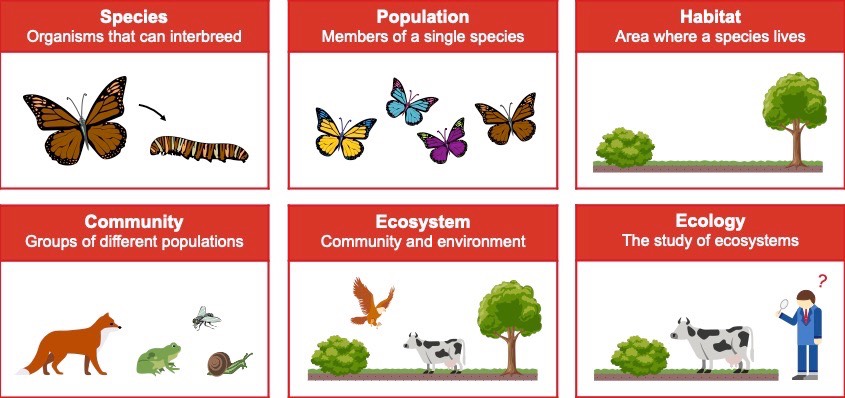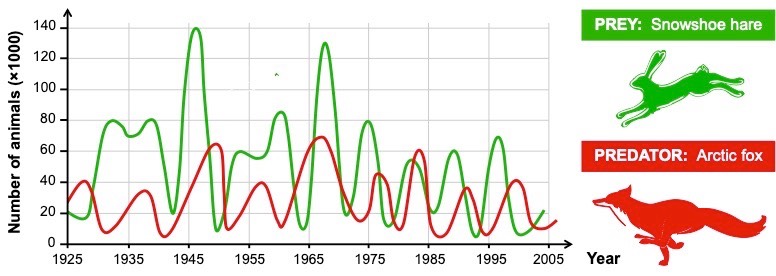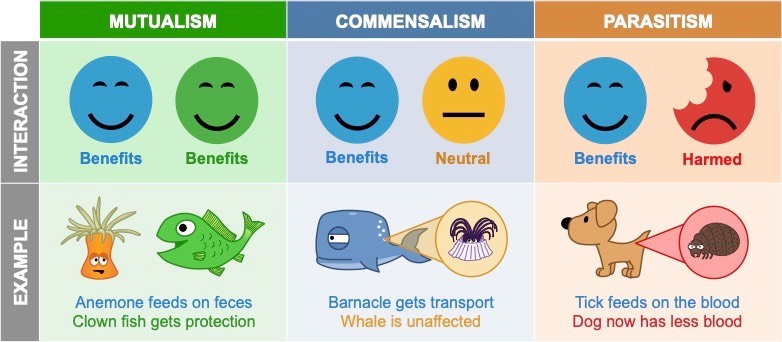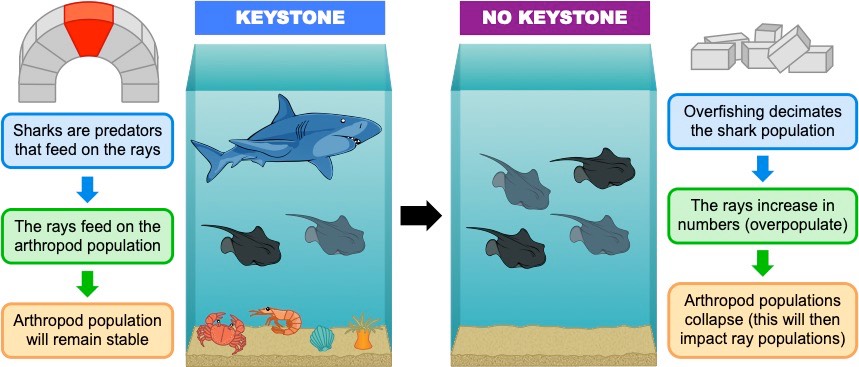Key Knowledge:
|
An organism’s capacity to survive will be determined by the characteristics it possesses that enable it to interact with the environment
- Environmental pressures (both abiotic and biotic factors) will limit the survival or organisms that lack suitable characteristics
- Hence, genetic diversity influences the survival prospects of a population or species by determining the frequency of specific traits
Ecological Organisation
Specific ecology terms are used to describe the interactions between organisms within a given environment, including:
- Species: A group of organisms that can potentially interbreed to produce fertile, viable offspring
- Population: A group of organisms of the same species, living in the same area at the same time
- Community: A group of populations living together and interacting with each other within a given area
- Habitat: The environment in which a species normally lives, or the location of a living organism
- Ecosystem: A community and its abiotic environment (i.e. habitat)
- Ecology: The study of the relationship between living organisms, or between living organisms and their environment

Survival Conditions
In ecology, a limiting factor is a component of an ecosystem which limits the distribution or numbers of a population
- A limiting factor defines optimal survival conditions according to its effect on a species when in deficiency or excess
- Limiting factors can be categorised as either being biotic (living) or abiotic (non-living)
The distribution of a species in response to a limiting factor can be represented as a bell-shaped curve with 3 distinct regions:
- Optimal zone – Central portion of curve which has conditions that favour maximal reproductive success and survivability
- Zones of stress – Regions flanking the optimal zone, where organisms can survive but with reduced reproductive success
- Zones of intolerance – Outermost regions in which organisms cannot survive (represents extremes of the limiting factor)

Abiotic Factors
Abiotic factors are the non-living conditions of an environment that influence the survival of organisms within an ecosystem
Abiotic factors may include:
- The resources an organism needs to survive (such as light, water, oxygen or carbon dioxide concentrations)
- Conditions that need to be maintained within a certain range (such as temperature, pH, radiation levels, salinity)
- Specific environmental events (such as weather patterns, climate conditions, natural disasters like fires or floods)
Abiotic factors will impact survival prospects and affect the density, distribution and size of a population within a given ecosystem
Biotic Factors
Biotic factors are the living components of an ecosystem that influence the survival of individual organisms and collective populations
- Certain species may need to interact (co-exist) within a shared environment in order to survive (they share a positive association)
- Examples of species interactions include predator-prey dynamics and symbiotic relationships (e.g. commensals, parasites, etc.)
Predator–Prey Relationship
Predation is a biological interaction whereby one organism (predator) hunts and feeds on another organism (prey)
- Because the predator relies on the prey as a food source, their population levels are inextricably intertwined
- If the prey population drops (e.g. due to over-feeding), predator numbers will dwindle as intra-specific competition increases
- If the prey population rises, predator numbers will increase as a result of the over-abundance of a food source

Symbiotic Relationships
Symbiosis describes the close and persistent (long-term) interaction between two species
- Symbiotic relationships can be obligate (required for survival) or facultative (advantageous without being strictly necessary)
Symbiotic relationships can be beneficial to either one or both organisms in the partnership:
- Mutualism – Both species benefit from the interaction (anemone protects clownfish, clownfish provides fecal matter for food)
- Commensalism – One species benefits, the other is unaffected (barnacles are transported to plankton-rich waters by whales)
- Parasitism – One species benefits to the detriment of the other species (ticks and fleas feed on the blood of their canine host)

Keystone Species
A keystone species is a species that has a disproportionately large impact on the environment relative to its abundance
- It is analogous to a keystone in an arch – it fundamentally supports the whole structure and prevents it from collapsing
Keystone species may influence communities in a number of ways:
- Predators – they can exert pressure on lower trophic levels to prevent them from monopolising certain resources
- Mutualism – they can support the life cycle of a variety of species within a community (e.g. pollinators / seed dispersal)
- Engineers – they can refashion the environment in a manner that promotes the survival of other species
There are numerous examples of keystone species within different communities:
- Sea stars (predator) prey on urchins and mussels, preventing mussel overpopulation and coral reef destruction by urchins
- Honey bees (mutualist) pollinate a wide variety of plant species, ensuring the continuation of the plant life cycle
- Beavers (engineer) build dams that transform the environment in a manner that allows certain other species to survive
Keystone species are not the dominant species (most numerous) within a community, nor do they have to be apex predators

Population Control
Limiting factors can exert their influence over populations via either top down or bottom up control mechanisms
- The difference between the two types of control relates to the position of the trophic level that is influencing the community
Top Down Control
- Top down factors are pressures applied by a higher trophic level to control the population dynamics of the ecosystem
- The top predator either suppresses the abundance of its prey or alters its behaviour to limit its rate of population growth
- Top down control results in an oscillating trophic cascade (suppression at one level increases numbers at the next level)
- Keystone species commonly exert top down control by preventing lower trophic levels from monopolising essential resources

Bottom Up Control
- Bottom up factors are pressures that limit the availability of resources to lower trophic levels (e.g. producers)
- A lack of resources at lower trophic levels suppresses the abundance of organisms at higher trophic levels
- Population growth will be reduced for all higher levels as the suppression of the 'bottom’ restricts energy supply to the ‘top'
- Human activity can often limit resource availability and hence inadvertantly exert bottom up pressure on an ecosystem
